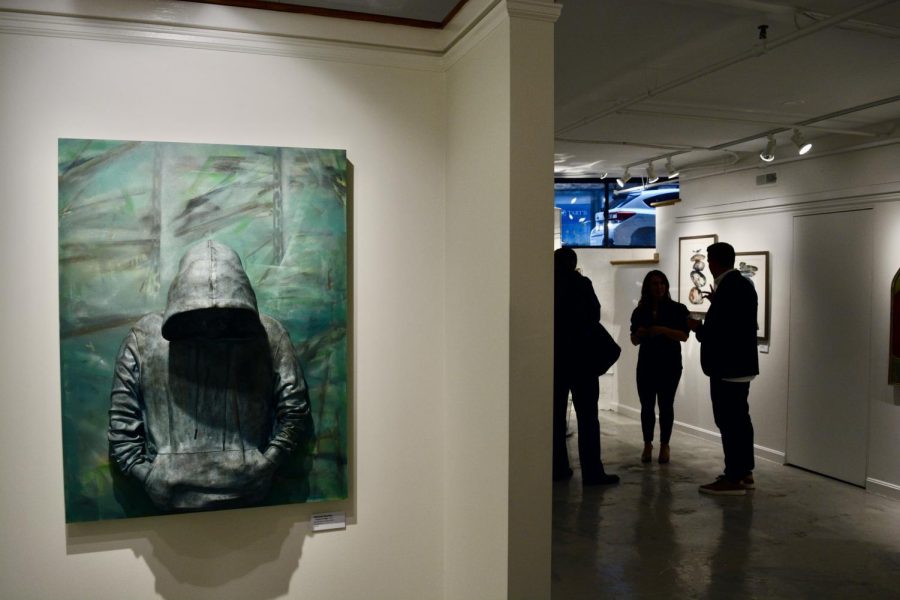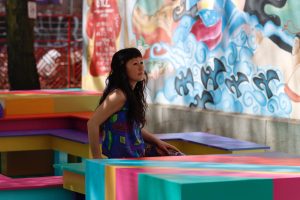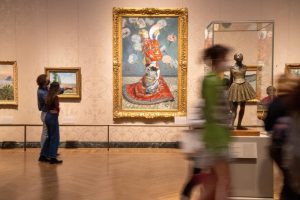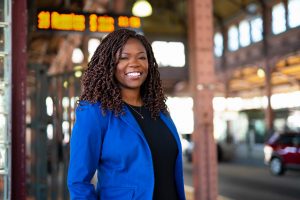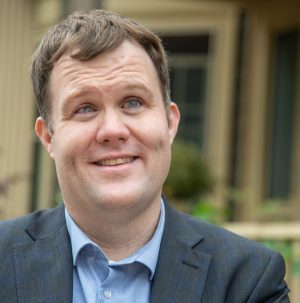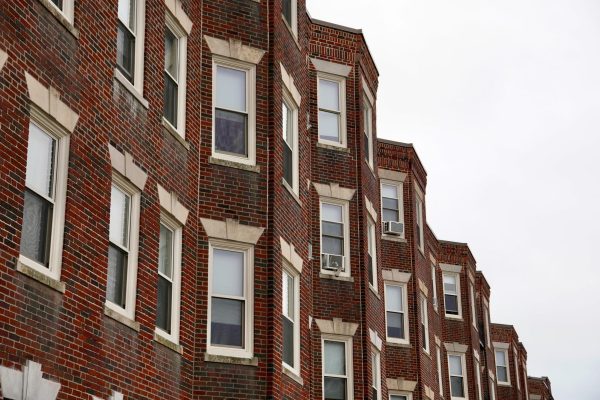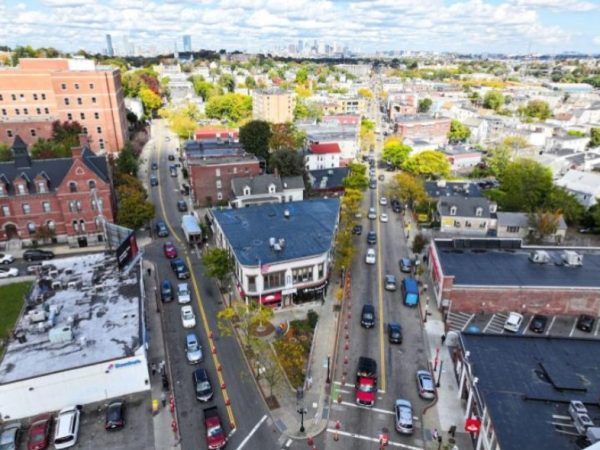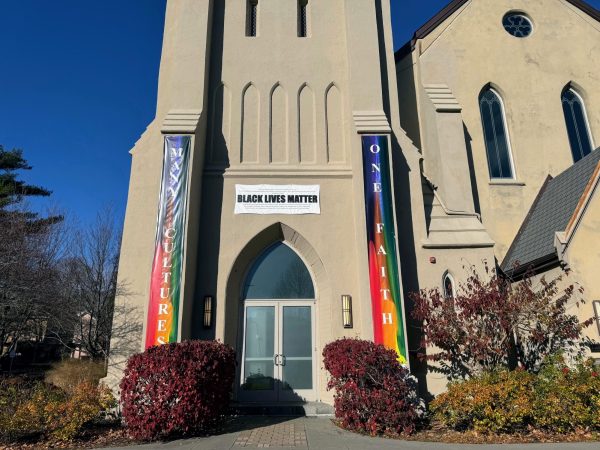Boston exhibition shines light on mental health in eclectic collection
Photo: Jennifer Suryadjaja
Domenic Esposito’s “Feeling Verdigris” features a bronze hooded figure on a wood panel. His work shines light on empathy for those struggling with mental health.
Since Christine O’Donnell opened Beacon Gallery in 2017, she has intentionally curated exhibitions with social justice in mind.
“It is something that I look at from a lot of different angles in the gallery, from just trying to make the gallery feel like a warm and welcoming place…” O’Donnell, gallery director, said.
O’Donnell collaborated with artists Domenic Esposito, Nicci Sevier-Vuyk and Sharon Whitham for her latest exhibition, “A Delicate Balance”, opening a conversation on emotional and environmental vulnerability.
“So what I am trying to show here is how challenging life can be, especially right now, in terms of balancing our lives and our mental, emotional, physical challenges that we all have,” O’Donnell said. “I had this idea that we’re on the inside to be one way, and yet on the outside, we can project a completely different personality, a different facade.”
The three artists chosen differ in craft but lend to the symbolism of objects and the weight of the mediums they choose to work with.
In Esposito’s bronze sculptures, such as “In Pieces” and “Feeling Verdigris,” the material symbolizes the literal weight of the medium and reflects its antiquity. He juxtaposes bronze against wood panels for added dimensionality in his work.
“I love the material because it gives the sense of longevity. You look at bronze sculptures [and think,] ‘oh, it’s been around forever.’” Esposito said. “And there’s also incredible weight to it. If you think about just how heavy the bronze sculptures are…there’s a hidden message to it because the work tends to be mentally heavy.”
O’Donnell worked with each artist individually to create a harmony on the walls of the Beacon Gallery. She was already familiar with their work and approaches, especially their mediums.
For O’Donnell, Whitham’s print-made “perfectly perched” stones contrast Sevier-Vuyk’s “incredibly ephemeral” acrylic-painted chrysanthemums and Esposito’s bronze sculptures paint a picture of a false, fragile reality.
“I often find that there are these harmonies in between them,” she said. “And I find it so fun to see how the colors in one person’s work speak to the colors in another person’s work, or the angles or the flow.”
Sevier-Vuyk’s vivid chrysanthemums are inspired by the garden flowers’ naturally long, tubular petals. Each flower blooms uniquely, crashing stereotypes of beauty from her viewpoint.
“I grow them myself, and they never come out the way they’re supposed to look,” Sevier-Vuyk said. “They’re asymmetrical, [and] they’re not uniform. They’re really weird-looking. I use color to emphasize that. So I’m poking fun at the stereotype of beauty and appearance. In that case, what we are told is beautiful in contrast to what I actually find beautiful in those flowers.”
Whitham’s rocks tell a story of our individual journeys through life, with each experience shaping an outcome.
“I feel like [rocks] also have their own journeys as we do. They’ve been shaped by erosion, weather, time and sense of time in history. They seem like something stable, yet, they’re not static. And the feather has an amazing strength to it, yet it’s also very fragile. I like the dichotomy of those things and what’s inherent in them,” Whitham said.
Whitham said creating monotypes has pushed her to become more open to experiencing what the world has to offer since it’s difficult to control the outcoming of printmaking, offering an element of serendipity.
“I have to say sometimes you get what you wanted, but more often than not, you don’t. And sometimes it’s better than what you expected, and sometimes it’s an utter failure. Quite honestly, that doesn’t scare me at all. I think failure is a part of the process, a part of art and you just learn from that and go on,” Whitham said.
Each of the three artists hopes to show viewers a different perspective on topics related to mental health. Sevier-Vuyk invites viewers to reflect on their perception of what beauty means, stripped from external influence.
“I would like the viewer to consider exploring the world around them outside of the paradigms pushed on us by society, outside the ideas given to us by the media and culture,” Sevier-Vuyk said. “Each person needs to look at the world outside of those boundaries and decide what is valuable and beautiful to them.”
Esposito’s background in sculpting goes back to 2018, when his 10 ft. long aluminum spoon sculpture landed on the outside steps of major pharmaceutical companies as a form of protest against the opioid crisis. His work is personal, largely due to his brother’s battle with substance use disorder for more than a decade.
“I think as a society, we need to start recognizing that [the opioid crisis] is, in fact, a disease, that we have the power to cure or at least alleviate, and have and use the art to create empathy for those struggling with it,” Esposito said.
Esposito strives to create a response through his works. In January, hospital staff who are on the frontlines flocked his solo exhibition at the Piano Craft Gallery since his work in mental health and substance abuse hit home. Esposito hopes his works evoke the same emotional response in “A Delicate Balance.”
“It was this sense of having an artist be a voice for them and in a piece of art that just resonated,” Esposito said. “As an artist, you want to reach a certain audience, but when you reach the people that it’s intended for, it’s incredibly rewarding.”
A Delicate Balance is open to the public until July 17, 2022.


